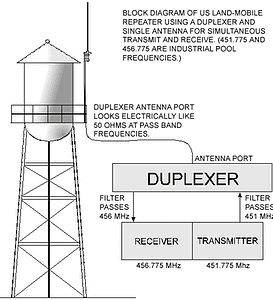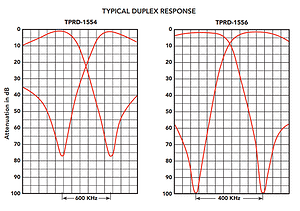How do Land Mobile Radio Duplexers work, and what should you know about them?
The term duplexer refers to an electronic device that enables forward and reverse (transmit and receive) signals to travel in a single signal path. For telecommunication applications with densely populated towers and expensive premiums on leasing antenna space, duplexers can allow a single antenna to operate as a transmit and receive antenna. As not all duplexers are created equal, there are several key aspects to consider when evaluating duplexers for a specific application.
For frequency division duplex (FDD) telecommunication systems, a filter-based duplexer can be used to lower the power of receive channel frequencies in the output transmitter signal path, and also filter out the transmit channel frequencies from the input receiver signal path. Hence, with a well designed duplexer, the transmitter signal will be so low in the receive signal path as not to affect the receiver, and there will be almost no loss of signal strength to the receiver from bleeding into the transmitter when the transmitter and receiver are connected to the same antenna.
Caption: An example figure of a duplexer used in a US Land-Mobile Repeater for simultaneous transmit and receive.
The maximum power handling, tuning range, channel frequency separation, insertion loss, and receiver isolation at the transmitter frequency are critical parameters for telecommunication duplexers and often come with trade-offs depending upon how well a filter-based duplexer is designed and constructed. The maximum VSWR, RF connector type, impedance, and the temperature range for reliable operation are other essential consideration factors for a duplexer.
Caption: The frequency response of a Pass-Reject Base Station Duplexer: Click here
An ideal duplexer would enable pure bi-directional communication without any interference, loss, or coupling between the two paths. Filter Q limitations, resistive losses, non-ideal material properties, design trade-offs, and manufacturing tolerances lead to non-ideal behavior in filter-based duplexers that limit the power handling, isolation, frequency separation, and VSWR performance of practical duplexers. For these reasons, reliability and consistent performance depend significantly upon the quality of the design, materials used, and manufacturing practices.
For example, in VHF and UHF frequencies, the resistive losses of common conductors are greater than at DC, and can cause heating of the filter elements or cavity. Moreover, many telecommunication tower and base station environments are subjected to wide temperature extremes and weather conditions that prevent effective climate control. Many other components in a base station are also radiating substantial amounts of heat, adding to the total heat in the environment. Metals and other filter construction materials typically expand or contract based on their temperature, and precisely tuned filters with only a few hundred kilohertz of frequency spacing are sensitive to these changes. Susceptibility to temperature variations could dramatically limit the power handling and environments that a filter-based duplexer could be employed.
However, there are materials and design techniques that can reduce the tuned frequency variation and isolation degradation over wide temperature ranges, reliably for years of virtually maintenance free operation. Using high thermal conductivity metal housing with substantial outer surface area and adequate spacing between the filter cavity stages can help to prevent excessive heat buildup within the filter structure. Using much higher conductivity metal plating, such as silver-plating on the filter tuning structures, can reduce the RF resistive losses that are converted to heat, and improve the insertion loss of the duplexer at transmission and reception frequencies.
Beryllium copper, a copper alloy with excellent thermal and electrical conductivity and mechanical stability, finger stock can also be used for the contactors to provide high structural integrity over years of intense use. Additionally, Invar, a metal alloy that physically changes very little over temperature, can be used for the filter rod material, which will prevent filter frequency behavior to fluctuate (detuning) over a wide range of temperatures.
AVW Group is an Exclusive Distrubutor of Telewave Products. For more information about Telewave’s High Performance Base Station Duplexers, click here.



